| If you can't see this e-mail properly, you can also view it online |
 |
|
NetLetter #1475 | December 11, 2021 |
|
|
 |
|
|
 |
|
|
|
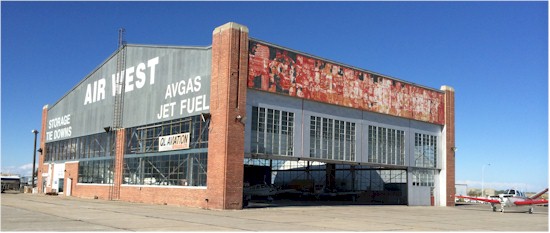 |
|
|
Hangar built by TCA at Lethbridge, Alberta in 1938
now a National Heritage Site
Photo found @ www.formercaptain.ca
|
|
|
|
|
|
|
|
|
|
Dear Reader,
Welcome to The NetLetter, established in 1995 as a dedicated newsletter for Air Canada retirees, we have evolved into the longest running aviation-based newsletter for Air Canada, TCA, CP Air, Canadian Airlines and all other Canadian-based airlines that once graced the skies.
The NetLetter is self funded and is always free to subscribers. It is operated by a group of volunteers and is not affiliated with any airline or associated organizations.
The NetLetter is published on the second and fourth weekend of each month. If you are interested in Canadian aviation history, and vintage aviation photos, especially as it relates to Trans-Canada Air Lines, Air Canada, Canadian Airlines International and their constituent airlines, then we're sure you'll enjoy this newsletter.
Please note: We do our best to identify and credit the original source of all content presented. However, should you recognize your material and are not credited; please advise us so that we can correct our oversight.
Our website is located at www.thenetletter.net Please click the links below to visit our NetLetter Archives and for more info about the NetLetter.
|
  |
Note: to unsubscribe or change your email address please scroll to the bottom of this email.
|
|
|
|
|
|
|

NetLetter News
|
|
|
|
|
 We have welcomed 226 new subscribers so far in 2021. We have welcomed 226 new subscribers so far in 2021.
We wish to thank everyone for your support of our efforts.
|
|
|
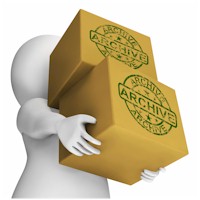 Back issues of The NetLetter are available in both the original newsletter format and downloadable PDF format. Back issues of The NetLetter are available in both the original newsletter format and downloadable PDF format.
We invite you to visit our website at www.thenetletter.net/netletters to view our archives.
Restoration and posting of archive issues is an ongoing project. We hope to post every issue back to the beginning in 1995.
|
|
|

We always welcome feedback about Air Canada (including Jazz and Rouge) from our subscribers who wish to share current events, memories and photographs.
Particularly if you have stories to share from one of the legacy airlines: Trans-Canada Air Lines, Canadian Airlines, CP Air, Pacific Western, Maritime Central Airways, Eastern Provincial, Wardair, Nordair, Transair, Air BC, Time Air, Quebecair, Calm Air, NWT Air, Air Alliance, Air Nova, Air Ontario, Air Georgian and all other Canadian based airlines that once graced the Canadian skies.
Please feel free to contact us at This email address is being protected from spambots. You need JavaScript enabled to view it.
We will try to post your comments in the next issue but, if not, we will publish it as soon as we can.
Thanks!
|
|
|
|
 |
|

Subscriber Feedback
|
|
|
|
|
First Automated Canadian Airline Ticket
by Mike Nash, Prince George, British Columbia – October 2021
Below is an image of the first trial automated Canadian airline ticket that I printed nearly half a century ago in February 1974 while testing Air Canada’s new ticket printing computer software.
The ticket stock came from the now long defunct U.S. carrier, Braniff, as we hadn’t yet reached the stage of having our own and Braniff was kind enough to let us have a box of theirs. Braniff and United Airlines were the only other carriers working on automated ticket printing at the time and I had earlier visited each of them in Dallas and Denver respectively to compare notes. In the years before deregulation, airlines were more disposed to share technology ideas.
Airline tickets 50 years ago were incredibly labour intensive to price and write by hand, especially for overseas or complex travel itineraries. This was amply demonstrated within a month or so of going live when an early-implementation glitch with the new system caused a near riot during the morning rush hour at Dorval airport. Within just a few short weeks, ticket counter agents had forgotten enough about calculating and hand-writing tickets, plus sufficient numbers of staff had already been reassigned, to create huge lineups and missed or delayed flights.
|
|
The project was an automation milestone in three important ways:
- We were working with early, cutting-edge microprocessor software that our engineers in Montreal, notably Robert Piette, had developed for Air Canada’s second generation CRT computer terminals.
- Physical airline tickets back then were almost like negotiable instruments and it was essential that we had tight control on what was being printed, in particular avoiding accidental duplicates. We had to achieve this in a network that was optimized for speed by means of a free-wheeling protocol that relied on agents to request a retransmission if something didn’t look right. During the first demo that I witnessed at UAL’s computer headquarters in Denver, to their embarrassment out popped a duplicate, a situation I’m happy to say we avoided at Air Canada.
- The folks who wrote the computer application programs that created the final ticket content had to find ways to automate the very complex fare calculations.
|
|
Air Canada’s first automated ticket printing went live in the spring or early summer of 1974, and it wasn’t long before we were working on the next generation of software as part of a network controller project contracted with Collins Radio of Dallas, Texas. My telecommunications software team and I spent some eight months working in Dallas on that project before the Texans moved to Toronto for final testing and implementation. It wasn’t long after this that Air Canada was looking at using the same or similar software to allow passengers to print their own boarding passes, and the future began to come into focus.
Those were interesting days with lots of fun parties.
|
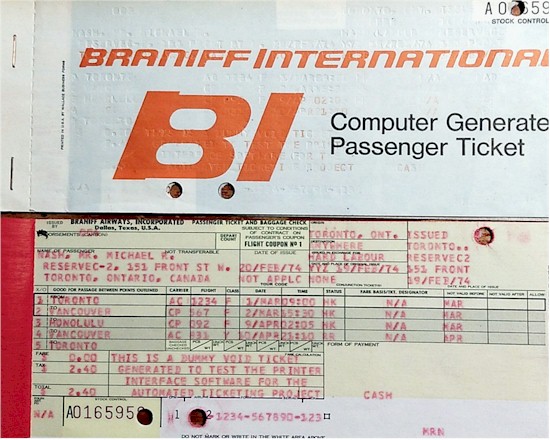 |
|
|
|
 |
|

Remember When
|
|
|
|
|
Mike Ronan shares this memory with us -
I may have been involved in what may have been one of the longest flights on a DC-9. On April 22, 1997 I was asked to ferry a DC-9 from Vancouver (YVR) to Toronto (YYZ).
We filled the tanks until fuel was dripping out of the wing-tips! Most of the pre-flight checks and briefings were done prior to starting the APU to preserve all fuel for the flight.
Ingrid Tamme was the first officer on this flight, and prior to engine start she called ground control to secure our taxi clearance. Engine start was delayed so there would be no fuel wasted. Our preference for an easterly departure would not be possible unless we were willing to accept a long delay according to the ground controller. So the only departure available would be toward the west on 26L.
The controller was advised of our plan to try a non-stop flight to YYZ, and he was very accommodating. He cleared us to the head of the line of airplanes and switched us immediately to tower control. Checks all complete, our engines had their minimum run of 3 minutes and we were rolling down the runway followed by a sporty turn to the left and directly on course.
The flight plan was initially filed for Minneapolis (MSP), then changed to Regina (YQG), and then finally cleared direct to YYZ where we landed with 3800 lbs. remaining in the tanks. LRC Mach # was used to maximum advantage with some nice tailwinds along the way.
Upon arrival we received a data-link msg from dispatch congratulating us, however one of the old timers over there thought that a similar flight had been done way back in the sixties. I would still like to find out!
Normally a DC-9 has somewhat less than 4 hours of "powered flight" in the tanks. This DC-9 flight took 4 hrs, 56 minutes according to my logbook.
Mike
|
|
|
 |
|

Women in Aviation
|
|
|
|
|
 King Schools has announced that Sarah Tamar has been awarded this year’s Women in Aviation, International (WAI) / Martha R. King Scholarship for Female Flight Instructors. King Schools has announced that Sarah Tamar has been awarded this year’s Women in Aviation, International (WAI) / Martha R. King Scholarship for Female Flight Instructors.
Tamar, who flies amphibious Cessna Caravans for New York seaplane service Tailwind, currently holds certificates and ratings including private pilot, instrument, seaplane and commercial.
Citing experiences with her own flight instructors and talking to children at a local WAI “Girls Can Fly” event as sources of inspiration to teach, she plans to use the scholarship to pursue her CFI.
Source: AVweb.com
|
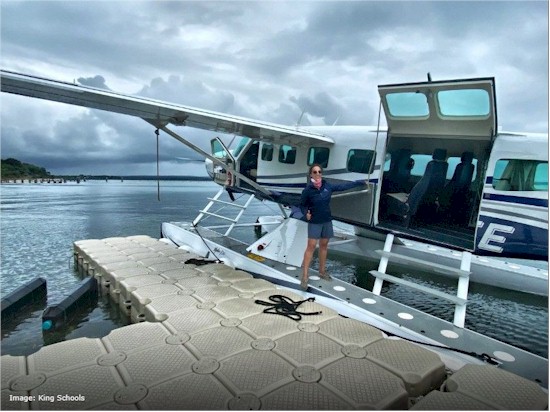 |
|
|
 |
|

Air Canada News
|
|
|
|
|
Air Canada Cargo’s First Freighter is Here!
The first of eight dedicated freighters is here and will soon commence regular cargo flying, providing additional capacity to key destinations in Europe and the Americas. This aircraft will initially support the shipping community during the busy peak season.
Converting Boeing 767-300ER passenger aircraft to freighters allows Air Canada Cargo to offer five different main deck configurations, increasing the overall capacity of each aircraft to over 57 tonnes (or 438 cubic metres), with approximately 75 per cent of this capacity on the main deck.
Click the image below to view the entire conversion in the timelapse video realased by Air Canada.
Source: www.aircanada.com/cargo/en/news-updates
Additional info: www.aircargonews.net
Editors' Note: We checked planespotters.net and see that 32-year-old Boeing 767-300(F), registration C-FPCA (fin #637), was converted for cargo operations in Tel Aviv and ferried to Toronto arriving December 5, 2021.
|
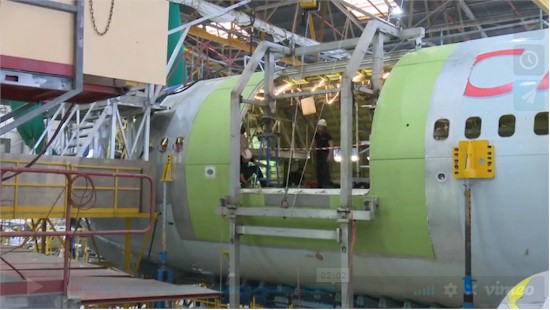 |
|
 for the latest posts at the Air Canada Mediaroom. for the latest posts at the Air Canada Mediaroom. |
|
 Click the logo to open the Air Canada YouTube channel. Click the logo to open the Air Canada YouTube channel. |
|
|
 |
|

Star Alliance News
|
|
|
|
|
United plans largest transatlantic expansion in its history.
United recently announced the largest transatlantic expansion in its history, including 10 new flights and five new, vogue destinations: Amman, Jordan; Bergen, Norway; Azores, Portugal; Palma de Mallorca, Spain; and Tenerife in the Spanish Canary Islands.
All the new routes, which are set to begin in spring 2022, are not served by any other North American carrier. Additionally, United will add new flights to five popular European destinations: Berlin, Dublin, Milan, Munich, and Rome. Lastly, United will launch seven routes that were interrupted due to the pandemic to Bangalore, Frankfurt, Tokyo's Haneda Airport, Nice, and Zurich.
Flights are subject to government approval.
Source: AC Daily October 19, 2021
Full story at: www.travelagentcentral.com
|
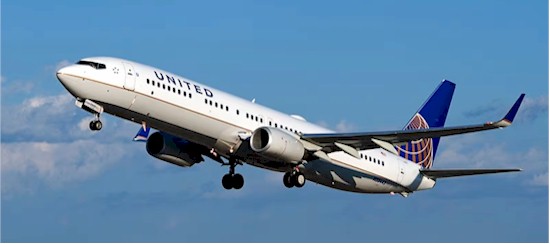 |
|
|
 |
|
TCA/AC People Gallery
 |
|
|
|
|

1987 - Air Alliance, formed as Air Canada's regional carrier in Québec, commenced operation. It served Montreal, Ottawa, Québec City and Bagotville until 1999, when it was absorbed into Air Nova.
2000 - April 3 - Inaugural service between Toronto and Mexico City.
|
|
|
 On April 25, 2018, a new group was set up in Facebook named 'Air Canada Family (ACF)'. August 17, 2018 the name was changed to 'Air Canada Family Friends (ACFF)'. On April 25, 2018, a new group was set up in Facebook named 'Air Canada Family (ACF)'. August 17, 2018 the name was changed to 'Air Canada Family Friends (ACFF)'.
The group is run by Ann Harper and Randy Moore, well-known, trustworthy and reliable retirees of Air Canada. It has no affiliation with Air Canada. Present membership totals 1,500+.
You are invited to join this esteemed group of Air Canada Family Friends, fondly referred to as ACFF, in the advancement of a movement to mobilize our seniors and keep active colleagues informed.
You will be part of the guiding beliefs or ideals which characterize a community that seeks and shares 'The Happy Days' of our AC careers.
www.facebook.com/groups
|
|
|

Found in 'Horizons' magazine
Issue dated May 1999
|
|
The YYZ Blues win it!
This year, 1999, the ACRA System Hockey Tournament took place in Vancouver from March 1 to 4, with a total of 12 teams participating.
A strong Toronto "A" Division team started off the tournament with an 18 - 0 trouncing of Vancouver Maintenance. Followed by an 8 - 1 victory over Montreal in game two which advanced the team into the final with the Vancouver Pirates, which Toronto won 7-3.
Here we have the victorious Toronto Blues team, the 1999 "A" Division champions.
Front row, left to right: Gregg Fortushniok, Station Attendant; Steve Spears, Mechanic; Dan Geisel, Matt McGuffin, Jeff Pasma and Sal Difede, Station Attendants.
Back row, left to right: Don Habkirk, Station Attendant; Ryan Campbell and Pete Delazzer, Lead Station Attendants; Tom Campbell and Jim Deluca, Station Attendants; Pete Gastis, Lead
Station Attendant and Darren Roach, Station Attendant.
|
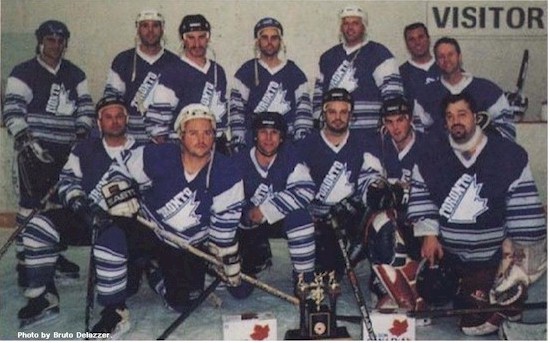 |
|
|
Bye Bye Bloor.
By Mary Manni, Day of Flight Coordinator, SOC, Toronto.
Before the employees of 130 Bloor Street, Toronto grabbed their bags and headed to the Air Canada Centre, they bid adieu to their 40-year-old home with a party-style Reservations rendezvous.
"Hollywood had the Oscars," says Mary Nizich, Manager, Customer Service, Toronto Reservations, "we had a 'Farewell to Bloor'."
Throughout the day, more than 300 active and retired employees chatted about old times and munched on finger food in the ever popular Club 130 lounge. For the last time, retirees took a walk around the offices.
Fifth floor farewell.
Employees on the fifth floor organized another midday soiree in the much used, but never abused, VP Conference Room. Amidst a room adorned with Trans-Canada Air Lines and Air Canada memorabilia, employees past and present reminisced over lunch.
Departments that have called Bloor Street home include Passenger Sales, National Sales, Corporate Communications, Corporate Sales, Sports Development, Law, City Sales Office, Yield Management, Message Edit, Customer Relations, Personnel, Sales Development and Communication, City Sales Office and Reservations.
"The move," Nizich says, "marked the end of an era and the start of a new beginning."
|
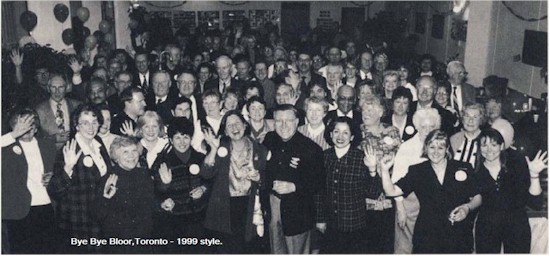 |
|
|
A story of a stripper!
B-767 C-GAUB fin# 601 c/n 22517, which, by 1999, had flown a total of 57,000 hours, was completely stripped of all its major parts - right down to its skin - for an H3 check.
Flight controls, landing gears, engines, galleys, seats were all removed. Then Montreal's Heavy Maintenance team went through the B-767 aircraft checking the wiring, replacing any corroded parts, painting the overhead bins, and restoring any defective equipment.
This check, which is conducted every six years, takes approximately 50 days to complete, and required the wide ranging expertise of 250 highly skilled employees, and costs over $1 million for the materials.
|
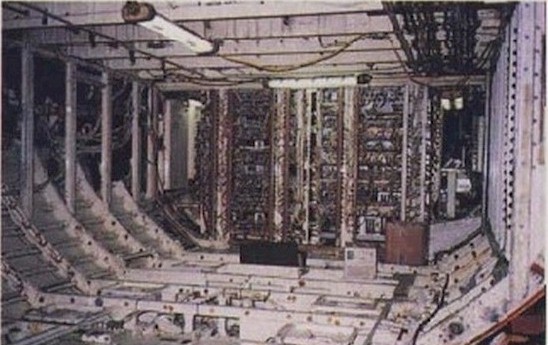 |
|
|
On hands and knees.
Remember when you were young (sigh..) and built tunnels in the snow? Crawling in them was exciting and fun.
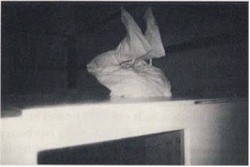 Well, some Tech Ops employees crawl into tunnels for a living. Known as tank sealers, they wiggle into the fuel tanks in an aircraft's wing to repair the tanks. Well, some Tech Ops employees crawl into tunnels for a living. Known as tank sealers, they wiggle into the fuel tanks in an aircraft's wing to repair the tanks.
Heavy Maintenance crew members, André Perkins and Michel Roy, developed the very special techniques needed to move around in such a confined space. They also built a fuel tank mock up. Perkins is pictured crawling through one that tests candidates who apply for a job as a tank sealer.
|
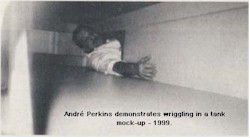 |
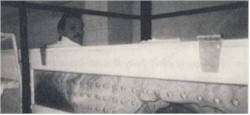 |
|
|
Issue dated July 1999
|
|
The RESIII Help desk and Database team enjoyed one of their last days at the Air Canada Centre in Montreal.
Kneeling: Norm Curley, Database Coordinator; Lino Mancino, Field Support Coordinator; Nicole Gendron, Senior Database Coordinator; Gloria Poirier, RESIII Field Support and Database
Manager; Teresa Galasso, Senior Field Support Coordinator and Louise Jolicoeur, Lead Database Coordinator DCS.
Standing: Jean Forget, Database Coordinator; Louis Notte, Senior Database Coordinator; Tina Fiala and Yves Frédéric, Field Support Coordinators; Lucie Mauro-Doyle, Manager, Reservations Development System; Lucie Plante, Database Coordinator; Chantal Cantin, Lead Database Coordinator, Systems; Errol Allen, Senior Field Support Coordinator; Florida Yessaian, Field Support Coordinator; Pamela Bardo, Field Support Specialist; Marie-Lou Dubois, PNR Retrieval; Jane Harlow-Glover, Field Support Specialist.
Absent Jenny Acheson, Suzie Falardeau and Sandra Holmes, Senior Database Coordinators; Nancy Magher, Lead Database Coordinator CIS; Christine Séguin, Senior Field Support Coordinator; and Ron Hiscox, Field Support Specialist.
|
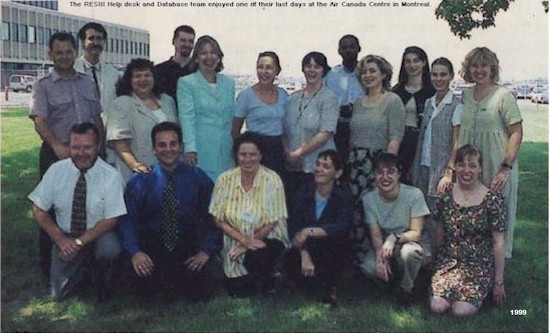 |
|
|
Issue dated August 1999
|
|
Latest A340 is in!
Late in the evening of June 28, 1999 our latest A340, fin #910, arrived in Montreal with some cargo revenue on board.
After going through pre-service modifications, it started service on July 1, 1999 at 17:00 on Rapidair. AC421 flew from Montreal to Toronto and then on to Zurich. Welcome to the Air Canada family!
Pictured here is Senior Vice President, International, Rupert Duchesne, kicking the tires to ensure they're full of hot air!
|
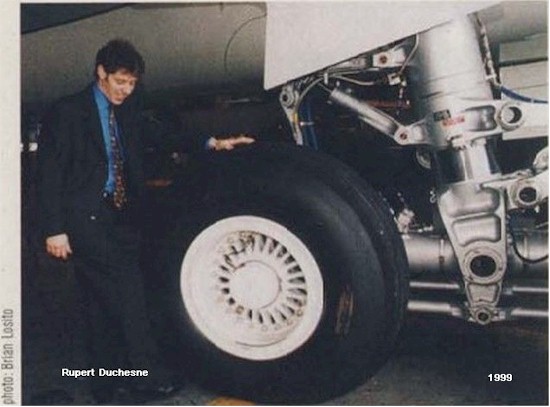 |
|
|
 |
|
CP Air, Canadi>n People Gallery
|
|
|
|
|
Eastern Provincial Airways historical fleet.
Source: Air Canada 75th anniversary book.
|
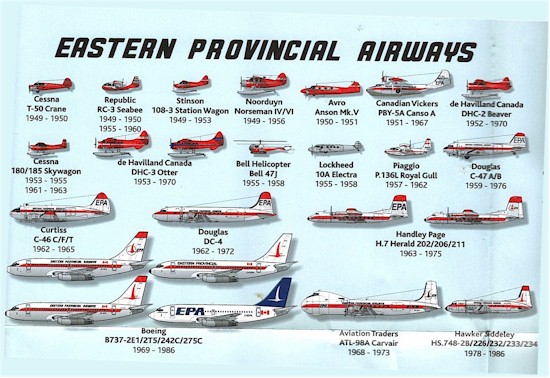 |
|
|

From the "InfoCanadi>n" magazine.
|
|
Issue dated March 1988
Excerpts from News Briefs section
|
|
During 1988, Amsterdam's Schiphol Airport had opened a special departure lounge for cows. Pre-flight drinks and food were served to Europe's increasing number of jet setting cattle.
At least 10,000 Dutch cows passed through the airport destined mostly for the Middle East. Schiphol also had an animal hotel where they could stay overnight to sleep off jetlag before continuing their journey.
|
|
|
On a special flight to raise money for children's charities world-wide a United Airlines B-747SP, flying east from Boeing Field, Seattle, Washington, set a new global speed record, January 28, 1988 by circling the earth in 36 hours, 54 minutes, and 15 seconds. The new record eclipsed the 1985 record held by a Gulfstream III that made the journey in 45.5 hours.
|
|
|
Trojan of California routes leaves service in April 1988.
Aircraft fin #766, a 19-year veteran of the B-737 fleet ended its service with the company on April 9, 1988. The aircraft was one of five sold October, 1987 to AIG Leasing of Hackensack, New Jersey. Also sold was fin #767, however it has been leased back for two-years.
The two aircraft were the only B-737s in the fleet fitted with First Class seats and for many years have been the workhorses of the California routes. Of the other aircraft sold, fin #793 left the fleet last October 1987. Fin #791 left at the end of June, 1988 and #792 left at the end of July 1988.
"The aircraft were sold as they were surplus to our requirements," explained Dennis Merrigan, vice president, fleet planning. The new B-767's coming on line beginning in April 1988 will improve the fleet's overall seating capacity.
The company now operates 72 B-737's, of which six are on short-term leases. All are model 200's except for three of the leased aircraft, which are model 300's. The company had no plans to acquire additional B-737's in the near future.
|
|
|
Service to Portugal came to an end on October 26, 1988.
The last flight being CP63 outbound from Lisbon to Toronto. The inaugural flight was May 30, 1957. A realignment of European routes gives Lisbon and other southern points to Air Canada, with
Canadian getting entry to Germany and other northern European cities.
|
|
|
 |
|

Featured Video(s)
|
|
|
|
|
Our 'Featured Video' was suggested by Ken Pickford -
Entitled 'Canadian Pacific Railway: History of a Design' and posted by AmtrakGuy365 the video focuses on the railway but a few mentions of CP Air in the section on the 1968 'Multimark' rebranding of all the CP subsidiaries. The two "script" style fonts mentioned prior to the Multimark were also used by the airline.
|
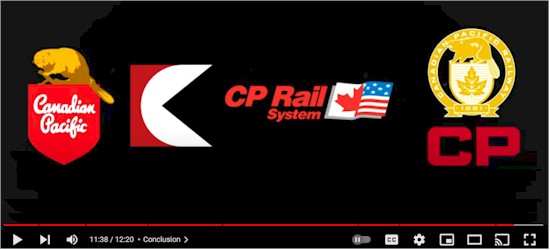 |
|
|
How Concorde Ended Up On A Museum Roof In Germany
Being such an iconic aircraft, most examples of Concorde have been preserved at airports and museums worldwide. Indeed, 18 of the 20 delta-winged supersonic airliners remain intact today. One of these is on display at the Technik Museum Sinsheim, in the German state of Baden-Württemberg.
It sits on the museum’s roof, but how did it get there? Click the image below to view the answer on YouTube (narration in German).
Additional info @ SimpleFlying.com
|
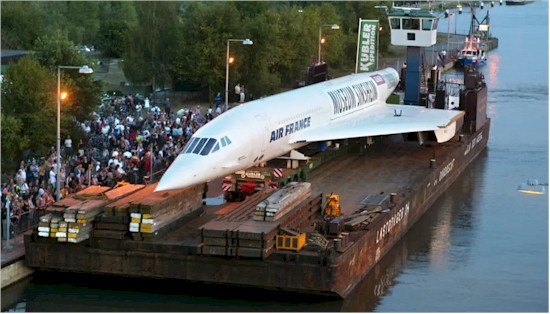 |
|
|
 |
|

Odds and Ends
|
|
|
|
|
Recovery Operation Of Transair Flight 810 Raises Wreckage And Cargo.
The National Transportation Board (NTSB) announced on November 2, 2021 that an insurance-funded recovery operation has successfully retrieved both flight recorders, all major components of the first-generation Boeing 737-200 freighter operated as Transair Flight 810 and its cargo. The NTSB has shared in the recovery effort, with a team of investigators on board the salvage vessels.
Along with both halves of the severed fuselage and its two JT8D engines, all eight cargo containers were recovered—six from the aft section of the fuselage and two more that were located on the sea floor separate from the wreckage. An additional cargo pallet was recovered during a previous salvage expedition.
Source: AVweb.com
Editors' Note: The aircraft ditched in the Pacific due to engine problems shortly after takeoff from Honolulu, en route to Maui, on July 1, 2021. The B-737-200C operating that flight was originally delivered to Pacific Western Airlines as C-GDPW in October 1975 and spent its first 20 years with PWA and Canadian Airlines.
See NetLetter #1466 for our previous story featuring this aircraft.
|
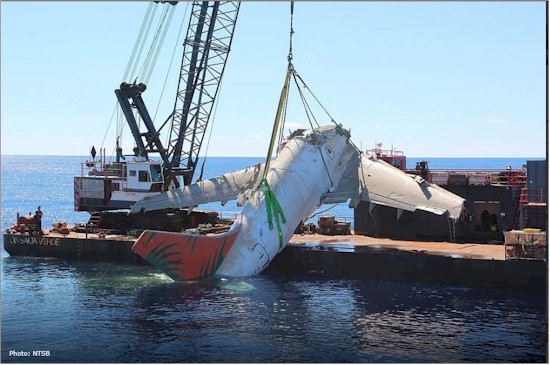 |
|
|
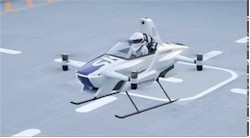 Japan has issued a type certificate for the Skydrive crewed octocopter and the company says it plans to have an air taxi service using a larger aircraft by 2025. It’s the first type certificate for a so-called “flying car” and was issued for the SD-03. The project is backed by Toyota. Japan has issued a type certificate for the Skydrive crewed octocopter and the company says it plans to have an air taxi service using a larger aircraft by 2025. It’s the first type certificate for a so-called “flying car” and was issued for the SD-03. The project is backed by Toyota.
It’s a single-seat vehicle that looks like a cross between a drone and a helicopter. It can go 30 MPH and only flies for about 10 minutes. The air taxi service will operate in the densely populated Osaka Bay area.
The company already operates a commercial drone service that flies payloads of up to 75 pounds to remote worksites in mountainous areas.
Source: AVweb.com
|
|
|
Lynx Air.
 A new Canadian airline announced its planned launch joining an increasingly crowded field of carriers jockeying for budget-minded travellers as the country emerges from the COVID-19 pandemic. A new Canadian airline announced its planned launch joining an increasingly crowded field of carriers jockeying for budget-minded travellers as the country emerges from the COVID-19 pandemic.
At an event at the Calgary International Airport, its new headquarters, start up Lynx Air announced its intention to begin flying sometime in 2022.
Lynx will combine low fares, a fleet of brand-new Boeing 737 aircraft (featuring leading-edge fuel-efficient technology and big overhead bins) and great customer service to create an exceptional travel experience.
Lynx, formerly known as Enerjet, a Calgary-based charter airline that announced in 2018 that it intended to transform itself into a commercial discount carrier, has some experienced aviation industry players behind it. The privately held company was founded by an investor group headed by Tim Morgan, a former senior executive at WestJet Airlines Ltd.
McArthur said Tuesday that Lynx will operate under the ultra-low-cost carrier model, which means passengers will be offered basic, bare-bones discount fares and then be charged extra for additional services like checked bags and cancellations.
Source: MSN.com
Click the image below to view YouTube videographer, Alex Praglowski's, video on LynxAir.
|
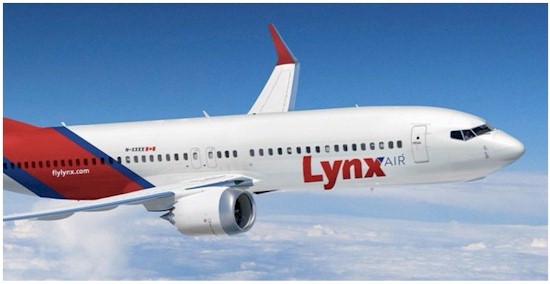 |
|
|
 |
|
 Wayne's Wings Wayne's Wings
|
|
|
|

Lethbridge and the Trans-Canada Airway
A few months ago, Ken shared the following with our NetLetter team:
"Came across following article (link below) dated 2000. Focuses on the role of Lethbridge as the original Alberta hub for TCA's transcontinental route in 1939 and through most of the 1940's, but also has pretty good description of TCA's early domestic operations in general.
Seems quite accurate, apart from a mix of 'Air Lines' and 'Airlines' in TCA's name. Reference to 'Trans-Canada Airway' in the title and elsewhere is to the route itself (airports, navigation facilities etc.) Photos aren't good enough for the NetLetter but might be worth including a link to the article in a future issue.
Produced by a couple of University of Lethbridge professors/lecturers, Ian MacLachlan and Bruce MacKay."
|
|
|
One of our most recurring themes at The NetLetter is how the movement of goods and services have shaped (and continue to shape) the aviation industry on Canada. The Lethbridge article chronicles the important role of mail service in the 1930's and how it was certainty a catalyst in the creation of Trans-Canada Air Lines.
Quoting from the article:
"On April 10, 1937, Trans-Canada Air Lines (TCA) was created as a crown corporation with a mandate to provide transcontinental air passenger, air mail, and air freight service. Why was a crown corporation created de novo when a private sector firm, Canadian Airways (precursor to Canadian Pacific Airlines and later Canadian Airlines International), was already in existence as Canada's largest air carrier?
The decision has been variously attributed to "a fit of absence of mind," the mutual distrust between James W. Richardson, founder of Canadian Airways, and CD. Howe, Minister of the Department of Transport, and by the unwillingness of Canadian Airways to participate in the new airline without having much influence in its management. Trans-Canada Air Lines was created as a wholly-owned subsidiary of Canadian National Railways."
|
|
|
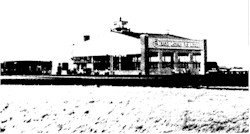
For the first nine years of trans-continental airline service, 1939-1948, Lethbridge was western Canada's principal airline hub. The city was ideally situated to fulfill this function due to its location on the southerly route of the 'Trans-Canada Airway' and the limited operational ceiling of the unpressurized Lockheed aircraft then in use.
In 1938 TCA built the hangar pictured here at Kenyon Field (now Lethbridge Airport (YQL).
The hangar is still standing today (pictured in this issue's header) and has (appropriately) been declared a heritage site.
It is well worth the time to open the links below for a couple of great reads on this historic era. |
|
|
 The original article by Ian MacLachlan and Bruce MacKay. The original article by Ian MacLachlan and Bruce MacKay.
|
|
Hangars and History:
www.formercaptain.ca/tag/tca
Lethbridge Airport history:
www.lethbridgeairport.ca/corporate/history
|
|
|
Click the image below for a larger view of the Trans-Canada Air Lines route map in 1939..
|
 |
|
|
 |
|

Terry's Trivia and Travel Tips
|
|
|
|
|
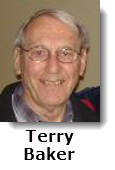 Terry Baker, co-founder of the NetLetter scours the internet for aviation related Trivia and Travel Tips for you, our readers, to peruse. Terry Baker, co-founder of the NetLetter scours the internet for aviation related Trivia and Travel Tips for you, our readers, to peruse.
|
|
Once the envy of airlines worldwide, the Emirates Airline fleet of four-engine, double-decker Airbus A380's is now destined for a futuristic program of a very different kind. As part of a contract between Emirates and UAE-based Falcon Aircraft Recycling, the first retired A380 aircraft will be “upcycled and recycled,” according to Emirates. The program is aimed at limiting the environmental impact of the deconstruction process.
Legacy salvage and recycling programs zero in on only the high-value components, such as landing gear and engines, but that leaves massive amounts of materials to either choke landfill sites or end up parked with little chance of generating any value.
“We are delighted to partner with Falcon Aircraft Recycling on this first-of-its-kind project,” said Tim Clark, president of Emirates. “Through this initiative, our customers and fans can take home a piece of aviation history while saving valuable materials from landfill and contributing to a charitable cause through the Emirates Airline Foundation. It’s an elegant and fitting retirement solution for this iconic aircraft and our flagship. We look forward to unveiling more information on the retail items soon.”
Source: AVweb.com
|
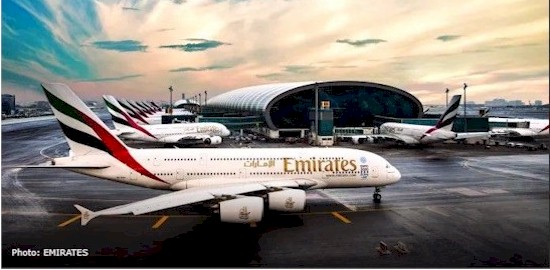 |
|
|
At the recent Dubai air show, the following deals were made -
Driving the deals were low-cost airline investor Indigo Partners, which ordered 255 Airbus A321neo and A321XLR aircraft for Wizz Air, Frontier, Volaris and JetSmart, while Indian low-cost start-up Akasa Air signed for 72 Boeing 737 Max 8's.
A 111 aircraft order from lessor Air Lease helped Airbus to dominate proceedings. Indeed, the deal launched the air framer’s new A350 freighter and meant the rumoured unveiling of a Boeing 777X freighter program did not materialize.
Among other aircraft-related developments, ATR secured a raft of small orders and announced a re-engining initiative, while Embraer said e-commerce was set to drive a long-term increase demand for air freight as it begins to study a freighter conversion programme for its E-Jets. Cargo was further evident as Boeing secured 20 more freighter conversions from DHL Express and Icelease.
Source: FlightGlobal.com
|
|
|
Researchers Design Carbon-Neutral Jet Fuel Process
Swiss researchers say they’ve figured out a way to make jet fuel out of thin air using solar power and can get the cost to as little as $5.25 a gallon.
Digital Journal is reporting the researchers say they can make “solar kerosene” by extracting carbon dioxide and water from air and cracking it using solar energy into “syngas,” a mixture of hydrogen and carbon monoxide.
That, in turn, can be turned into kerosene, methanol and a host of other hydrocarbons that are normally produced from oil and gas.
Because the process uses carbon dioxide from the air, the “solar kerosene” is carbon-neutral when it burns and will presumably meet all the standards for aviation use.
Source: AVweb.com
|
|
|
 |
|

Smileys
|
|
|
|
Quote attributed to Golda Meir, former Prime Minister of Israel -
“Old age is like a plane flying through a storm. Once you’re aboard there’s nothing you can do.”
Source: best-quotations.com |
|
 |
|
|
|
|
The NetLetter Team
|
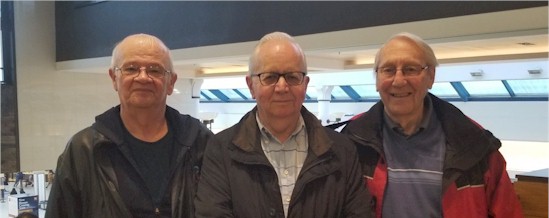
|
|
Wayne Albertson, Ken Pickford & Terry Baker
Richmond, British Columbia - December 2019
(Bob Sheppard was not available for the photograph)
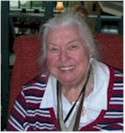 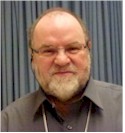
We wish to honour the memories of
Vesta Stevenson and Alan Rust.
They remain a part of every edition published.
|
|
|
|
|
Subscription Management
We presently have the following subscription info within your profile:
First Name:
Last Name:
Email:
City:
Province/State/County:
Country:
Updating your profile: If you'd like to change your email or update the information in your profile, please click on the button below.
We appreciate knowing your city & country of residence so that we can add content relating to your region.
Thank you.
{modify} {/modify} {/modify}

Unsubscribe - We'd hate to see you go, but realize the NetLetter isn't for everyone. If you never read the NetLetter or delete it without reading it, please do us both a favour and unsubscribe.

|
|
|
|
|
|
|
E&OE - (errors and omissions excepted) - The historical information as well as any other information provided in the "NetLetter" is subject to correction and may have changed over time. We do publish corrections (and correct the original article) when this is brought to our attention.
Disclaimer: Please note that the NetLetter does not necessarily endorse any airline related or other "deals" that we provide for our readers. We would be interested in any feedback (good or bad) when using these companies though and will report the results here. We do not (normally) receive any compensation from any companies that we post in our newsletters. If we do receive a donation or other compensation, it will be indicated as a sponsored article or link.
|
|
|
|
|































 We have welcomed 226 new subscribers so far in 2021.
We have welcomed 226 new subscribers so far in 2021.



























 Wayne's Wings
Wayne's Wings




 {/modify}
{/modify}